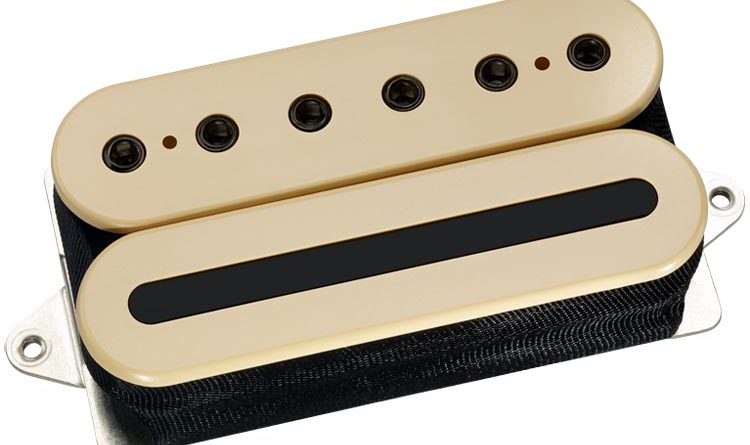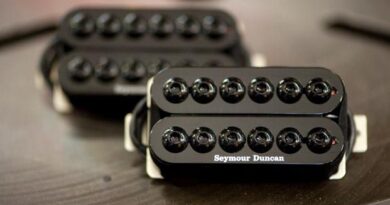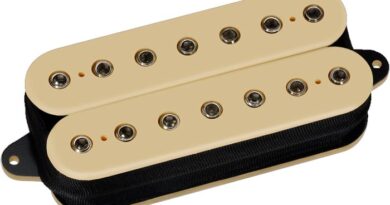DiMarzio D Sonic DP207 Humbucker

The D Sonic is sort of a middle child in the DiMarzio catalog. It is the second of three DiMarzio humbuckers with the same unique design. And it is also between the tonal properties of the predecessor and the successor.
Sandwiched between the mid-80’s MegaDrive and the 2009 Crunch Lab, the D Sonic was first released in 2003 as the Drop Sonic. Specifically, what I have for evaluation purposes is the Drop Sonic. DiMarzio suggests it’s the same thing, so we’ll proceed with that assertion as factual.
First, let’s hit up the scene with that name. The “drop” in Drop Sonic comes as a nod to the drop tuning practice. The D Sonic is a relatively bright-sounding pickup, so lower tunings would be on the menu.
How about that rad look?! One bobbin is the classic 6 pole screws. The other bobbin is a solid bar. We’ve pretty much gotten used to that visual by now. The Average Joe in 2003 might have forgotten about the old 1980’s MegaDrive, so this appearance was probably a trip when it first came out.
But there is a bit of reasoning behind those adornments. Like the pole screws, the bar is what works with the magnetic field of that super chunky ceramic magnet. The suggestion is that the bar covers the full range for E string to E string, not allowing the potential for drop off between poles (i.e., string bends).
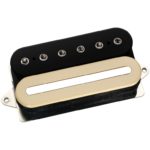
Now, if you’re a dork (like me!) you might have some Magnetic Field Viewing Film and you can actually look at the differences and similarities of each bobbin’s magnetic field. While technically speaking, yes, there is a more even coverage, I’d maintain it’s not the sort of difference heard with the levels of gain generally used for drop-tuned music. LOL! But I think there’s something else going on with the D Sonic, not too far gone from the design of the MegaDrive.
The D Sonic has a bit of an asymmetrical design to the coils. The bar coil is in the 6k range and the screw coil is lower in the 4k range. Compared to the MegaDrive, where the bar is the lesser and the screw is stronger. Methinks this might be one of the biggest validations of how the D Sonic can be marketed as “the design is completely different” from the MegaDrive.
It can be rare at times to find passive pickups with two perfectly matching coils. Even if the DCR of each coil is >1% variance, that doesn’t mean the physical geometry of the winds are 100% identical. However, this is where offset coils are intentional. Generally speaking, this can open up the voicing a little (or a lot!). DiMarzio claims they can tune coils like this for different frequencies… which I tend to wonder if they might throw darts at the wall until they get it dialed in and call it science. LOL!
And even with all that, I tend to end up looking at the D Sonic with how the DCR is paired with the bar and with the poles. My experiences with this model and with the MegaDrive prompt me to consider the two are clearly variations on a theme. In all the aforementioned ways.
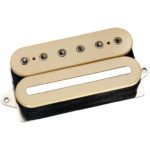
To check it out, I put the D Sonic in the same guitar I tested the MegaDrive. A hum-single-single super-strat shred-stick with a double-locking tremolo, tuned to E standard.
Once again, the D Sonic is a bit of a bright pickup. Going with standard tuning might take off the top of your head and leave you a little punch drunk. Lots of cut, plenty of focus, and a snarl in the mids. Before you ask, that’s pretty much my experience with the poles/bar in either configuration. The bright nature can be more accentuated with the bar bobbin set closer to the bridge.
For cleaner tones, splitting to the pole bobbin might be a good place to start on the D Sonic. I suggest that both for the lower DCR and for the slightly less precise nature of that coil – particularly when placed away from the bridge.
Something that I do see are some players using the D Sonic for a neck position humbucker. The 11k DCR range isn’t all that unreasonable for that application. And the brighter nature would lend itself well in the neck slot. Starting with the bar coil closer to the neck is a popular suggestion.
DiMarzio is hurting when it comes to an official video for the D Sonic. But I do have a jam on the D Sonic 7 by DiMarzio artist Art Rodriguez (solo artist, Delyrium).
Wanna see some specs?
Series – 11.359 K
Inductance – 6.266 H
Bar – 6.433 K
Screws – 4.943 K
Parallel – 2.794 K
B – 6.5
M – 6.5
T – 5.5
Magnet – Ceramic
Output – 390 mV
The D Sonic is obviously going to be suited for you if you’re looking for a pickup that can handle nu metal, metalcore, progressive metal, extreme metal, heavy metal, any drop tunings, or a style needing a detailed upper midrange.
For reference, this DiMarzio D Sonic DP207 humbucker pickup evaluation was conducted with a Fractal Axe-Fx II XL+ featuring Celestion Impluse Responses and Fractal MFC-101 MIDI Foot Controller. Real cabs used were Marshall 1960B cabs loaded with Celestion G12-65s, Vintage 30s and G12M Greenbacks.

